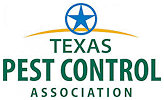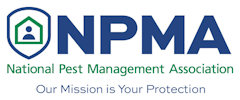The cockroach is a class of insects in the order Blattodea. They exist throughout the entire world with the exception of the Polar Regions and in elevations in excess of 6,500 feet or 2,000 meters. Cockroaches are generally scavengers and are mainly nocturnal, and will run away when exposed to light. A peculiar exception is the Oriental cockroach which is attracted to light, thus making it a far more annoying pest. The roach is also one of the hardiest insects on the planet, capable of living for a month without food and remaining alive headless for up to a week. It can also hold its breath for 45 minutes and has the ability to slow down its heart rate.
There are about 4,600 cockroach species in the entire world. Although we deal with several species in Texas, there are four cockroaches that we generally deal with on a daily basis: the German Cockroach, American Cockroach, Oriental Cockroach, and the Smokey Brown Cockroach. These cockroaches are the most commonly targeted by Envirotrols’ Cockroach Control Programs.
Envirotrols' Treatment Programs manage cockroach infestations to make sure they do not come back. The Envirotrol Approach is a multi-step program using a wide variety of products including residual dusts, gas injection into cracks & crevices, residual sprays, baits, and more.
Full treatment notices are provided (printed in English and Spanish) to aid residents and building occupants properly prepare.
To help prevent the return of a cockroach infestation, limit water sources, leaky pipes, etc. Limit food access to roaches by sweeping up food debris, keeping pet food sealed, and removing grease from around the stove.
German Cockroach
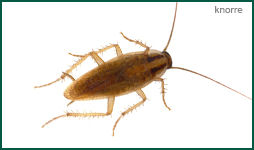
German Cockroach - Blattellagermanica
ID: The German cockroach is a small species of cockroach, typically about 2/5”-3/5” (11-16mm) long. In color it varies from tan to almost black, and it has two dark, roughly parallel, streaks on the pronotum running anteroposteriorly from behind the head to the base of the wings. AlthoughBlattellagermanicahas wings, it can barely fly, although it may glide when disturbed.Of the few species of cockroach that are domestic pests, it probably is the most widely troublesome example.
German Cockroaches occur widely in buildings, but is particularly associated with restaurants, food processing facilities, hotels, and institutional establishments such as nursing homes. The German cockroach reproduces faster than any other residential cockroach, growing from egg to reproductive adult in approximately 50 – 60 days. Once fertilized, a female German cockroach develops an ootheca (egg mass) in her abdomen. The abdomen swells as her eggs develop, until the translucent tip of the ootheca begins to protrude from the end of her abdomen, and by that time the eggs inside are fully sized. The ootheca, at first translucent, soon turns white and then within a few hours it turns pink, progressively darkening until, some 48 hours later, it attains the dark red-brown of the shell of a chestnut.
The newly hatched 3mm-long black nymphs then progress through six or seven instars before becoming sexually mature, but ecdysis is such a hazardous process that nearly half the nymphs die of natural causes before reaching adulthood. Molted skins and dead nymphs are soon eaten by living nymphs present at the time of molting.
The German cockroach is very successful at establishing an ecological niche in buildings, and is resilient in the face of many pest control measures. Reasons include lack of natural predators in a human habitat, prolific reproduction short reproductive cycle, the ability to hide in very small refuges, and sexual maturity attained within several weeks. German cockroaches prefer confined spaces, so they can hide within small cracks and crevices that are easy to overlook, thereby evading humans and their eradication efforts. Conversely, the seasoned pest controller is alert for cracks and crevices where it is likely to be profitable to place baits or spray surfaces.
American Cockroach
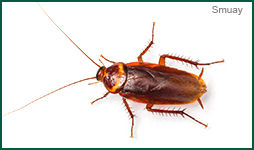
American Cockroach - Periplanetaamericana
The American Cockroach, also colloquially known as the waterbug, but not a true waterbug since it is not aquatic. It is the largest species of common cockroach, and often considered a pest. American cockroach are an average length of around 2” or 5cm. They are reddish brown and have a yellowish margin on the body region behind the head. Immature cockroaches resemble adults except they are wingless. The cockroach is divided in three sections; the body is flattened and broadly oval, with a shield-like pronotum covering its head. A pronotum is a plate-like structure that covers all or part of the dorsal surface of the thorax of certain insects. They also have chewing mouth parts, long, segmented antennae, and leathery fore wings with delicate hind wings.
American cockroaches generally live in moist areas, but can survive in dry areas if they have access to water. They prefer warm temperatures around 84 °F (29 °c) and do not tolerate cold temperatures. These cockroaches are common in basements, crawl spaces, cracks and crevices of porches, foundations, and walkways adjacent to buildings. In residential areas outside the tropics these cockroaches live in basements and sewers, and may move outdoors into yards during warm weather.
American cockroaches are omnivorous and opportunistic feeders that eat a great variety of materials such as cheese, beer, tea, leather, bakery products, starch in book bindings, manuscripts, glue, hair, flakes of dried skin, dead animals, plant materials, soiled clothing, and glossy paper with starch sizing. They are particularly fond of fermenting foods.They have also been observed to feed upon dead or wounded cockroaches of their own or other species.
In cold climates, these cockroaches may move indoors when the weather turns cold, seeking warmer temperatures and food. Cockroaches may enter houses through sewer connections, under doors, or around plumbing, air ducts, or other openings in the foundation. Cockroach populations may be controlled through the use of insecticides. Covering any cracks or crevices through which cockroaches may enter and cleaning any spills or messes that have been made is beneficial, so cockroaches are not able to enter and are not attracted to the food source. Another way to prevent an infestation of cockroaches is to thoroughly check any material brought inside.
Oriental Cockroach
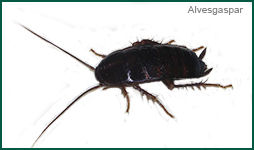
Oriental Cockroach - Blattaorientalis
ID: The Oriental Cockroach is a large species of cockroach, adults being around 7/10”-1.1” or 1.8–2.9 cm. It is dark brown to black in color and has a glossy body. The female has a somewhat different appearance from the male, appearing to be wingless at casual glance, but has non-functional wings just below her head. She has a wider body than the male. The male has long wings, which cover two-thirds of the abdomen and are brown in color, and has a narrower body. Both are flightless.
Signs of cockroaches are their oothecae, which are “egg cases”. The blackish-brown oothecae of the oriental cockroach are 2/5”-1/2” or 10–12mm long, with indistinct egg compartments housing 16–18 eggs. These oothecae are formed a day after mating, and typically deposited a day or two after formation, though can be deposited up to 7 days later, typically in a sheltered area. They are initially a yellow white, turning reddish- then blackish-brown. They hatch on their own in about 2-3 months.
Oriental cockroaches tend to travel somewhat more slowly than other species. They can often be found around decaying organic matter, and in sewers, drains, damp basements, porches, and other damp locations. They can be found outside in bushes, under leaf groundcover, under mulch, and around other damp places outdoors. They are major household pests in parts of the Northwest, Midwest, and Southern United States.
Oriental cockroaches can be harder to get rid of than other roaches. Although adults can be fairly easily killed by the application of residual insecticide, the insecticides can get washed away, and two months later females can hatch new nymphs.
Nymph & Egg Case (Ootheca)
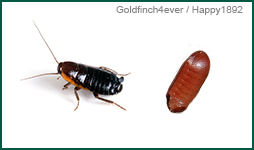
This cockroach is a troublesome pest due to their reproductive rate. They also go through an incomplete metamorphosis, meaning that the nymphs are generally similar to the adults, except for undeveloped wings and genitalia. When the nymph grows it sheds its old skin and grows into a larger nymph, and they do this until they reach adulthood. Adult female cockroaches also create an ootheca, which is a type of egg mass containing hundreds of eggs waiting to hatch into cockroach nymphs. The ootheca’s appearance varies between each cockroach species, but they generally look like little, ridged bags often brown in color.
Thus cockroaches leave behind a lot of debris making it easy to identify an infestation. If you see any of these discarded exoskeletons and/or egg sacs please clean them up as they not only provide food for the cockroaches, as they are rich in protein, they may prevent new eggs from hatching to begin with. The E-Systems Cockroach Control program uses growth regulators to stunt the growth of young, nymphal cockroaches to prevent them from reaching peak sexual reproduction.
